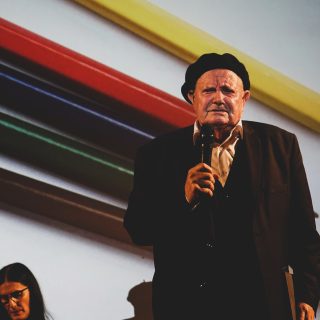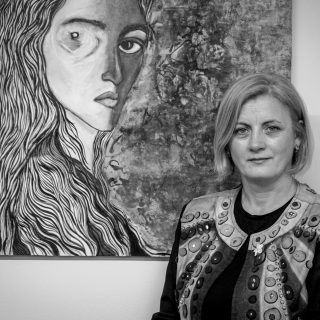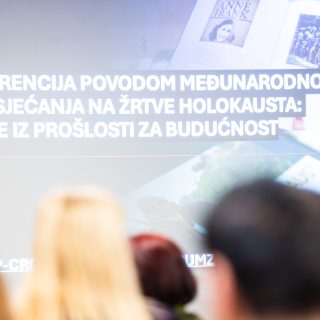Marijana Toma
In armed conflicts in the former Yugoslavia, between 1991-2001, more than 130,000 persons lost their lives, several million became refugees or internally displaced persons, and we are still looking for approximately 10,000 missing persons. Tens of thousands of people suffered as victims of different war crimes committed in these conflicts: mass killings, enforced disappearances, systematic rape and other forms of sexual violence, and torture in numerous concentration camps and detention centers. Despite a significant number of judicially established facts in front of the International Criminal Tribunal for the former Yugoslavia (ICTY) about these crimes, and different initiatives (of mostly civil society) for dealing with the past, states in the region continued to create intense conflicts through nurturing of nationalistic narratives about past wars, mostly based on self-victimization and a complete lack of empathy for the suffering of members of other ethnic groups.
After political changes in October 2000, among other difficulties, Serbia faced the challenges of constructing responsible and honest relations towards the legacy of war crimes committed by the members of the Serbian forces in the conflicts in the territory of the former Yugoslavia. This effort was one of the most important preconditions for reconciliation with its neighbors, Bosnia and Herzegovina, Croatia, and Kosovo. Despite some progress achieved in Serbia since the political changes in 2000 in the implementation of certain mechanisms of transitional justice, the overall definition, implementation, and fulfillment of main goals and strategies for dealing with the legacy of atrocities committed in the 1990s wars were not treated as a priority. The transitional justice process was not the result of the honest intention of political elites to reconcile with neighbors. On the contrary, political elites expressed that will and intention only as the result of political conditioning and pressure from the international community and its institutions. Meanwhile, in Serbia, responsibility for crimes committed by members of Serbian forces was denied, or rationalized by insistence on crimes committed against Serbs, which exaggerated the numbers of Serbian victims, and minimized the numbers of victims of other ethnic groups.
Consequences of this kind of relation towards the crimes from the past are dangerous for society in many ways, but most of all for generations born immediately before and after the wars. Not only have younger generations never played a significant role in initiatives for dealing with the past and the implementation of transitional justice, but these generations are also the inheritors of dominant narratives about their own nation as the only or the biggest victim of armed conflicts in the 1990s. An additional problem is found within the system of formal education that presents distorted portrayals of the recent past, through selective presentation of facts and biased interpretations of wartime events. This problem is especially prevalent in the presentation of war crimes from the 1990s in history textbooks in Serbia, and the interpretation of the recent violent past that they encourage young people to adopt.
In its Analysis of the content of history textbooks in Serbia regarding the wars in the former Yugoslavia in the light of the facts established before the ICTY, published in December 2015, the Humanitarian Law Center (HLC) has presented the most comprehensive study of the presentation of facts about war crimes in history textbooks in Serbia.[1] According to the HLC’s conclusions, atrocities committed in the former Yugoslavia are presented in a biased and superficial manner, with selective choice of desirable information, in order to present Serbs as the only and/or biggest victims of conflicts in 1990s, while the facts about suffering in other nations in the region, or Serbian responsibility for that suffering, have been completely neglected. Additionally, the textbooks give more attention to the dissolution of the Socialist Federal Republic of Yugoslavia (SFRY), while the narratives about wars, and especially war crimes, are presented only in few sentences. The biased manner is noticeable even within the sections that explain the political crisis that lead to the dissolution of the the former Yugoslavia, which attributes all responsibility for the dissolution of state union to the ‘separatist’ tendencies of Croatian and Albanian nationalism.
The causes and consequences of the conflict in Croatia receives the most attention in Serbian history textbooks, even though it was not the most intensive or devastating conflict in the former Yugoslavia, when taking into account the number of killed and disappeared, nor it was conducted on the territory of Serbia, as Kosovo conflict. A significant amount of attention is given to destruction in and around Vukovar in the beginning of the war, and there is no mention of crimes committed by Serbian forces against Croatian civilians on territory that was under control of Serbian forces. Most attention was given to the Croatian Army and Police operations from 1995, ‘Flash’ and ‘Storm’, in which ‘planned ethnic cleansing of Serbs from Western Slavonia’, as well as of ‘Serbs from Lika, Kordun, Banija and Dalmatia’ was committed.[2] As for victims killed while living in Croatia, only members of the Serbian people are mentioned.
The war in Bosnia and Herzegovina received the least attention in Serbian history textbooks, even though it was the most intense conflict, as indicated by the number of crimes committed (the largest number of indictments before the ICTY were raised for the atrocities committed in B&H), the number of persons killed and disappeared (approximately 100,000) and the number of Serbs killed (around 25,000). Crimes committed in Bosnia and Herzegovina are mentioned in general terms, without any details on legal definitions of crimes, who was responsible for suffering, or ethnic information about victims. Only to the crime in Serbrenica receives more attention, although most textbooks avoid the legal definition of genocide, as established in numerous ICTY judgments of members of political and military leadership of Bosnian Serbs. Only one of the textbooks is more specific about the war crimes trials for Srebrenica. However, this textbook also mentions that the number of victims (8,000 Bosniaks) is still disputable, and there are still credible discussions on victims. Besides that, the authors are completely inaccurate when claiming that the International Court of Justice (ICJ) in The Hague’s judgement in the case of Bosnia and Herzegovina against Serbia recognized that the genocide committed in Srebenica had nothing to do with Serbia. In fact, on the contrary, the ICJ judgment did proclaim that Serbia was responsible for violating the Convention on prevention and punishment of the crime of genocide, for not preventing the genocide and not punishing those responsible.
The armed conflict in Kosovo is presented only through the perspective of the NATO bombing, which focuses on victims that were killed by NATO forces, material damage inflicted on Serbia between March and June in 1999, and suffering of non-Albanians in Kosovo after the withdrawal of the Serbian Army and Police. The precise numbers of destroyed houses, schools, hospitals and memorials are mentioned, although the numbers of civilians that lost their lives are only mentioned as estimations (between 1,200 and 2,500 persons). Even though a significant number of political and military leaders of Serbia has been declared guilty and sentenced for crimes in Kosovo, Serbian textbooks do not mention the suffering of Albanian civilians (more than 10,000), before or during the NATO bombing.
These interpretations of the wars from the 1990s in history textbooks in Serbia do not contribute in any positive manner to the critical perception of the past, or the education of new generations that would contribute to the process of reconciliation in the region. On the contrary, as mentioned by historian Dubravka Stojanovic, the presentation of such narratives serve as ‘pre-military training’ and preparation for future decision makers to create new conflicts. The mobilization of new generations through the system of formal education, when added to the dominant narrative about Serbia as a ‘nation-victim’ that political elites and the media present to them, successfully prevents the process of dealing with the past, because it hinders the dismantling of the ‘pledge of silence’ that older generations abide by when their children ask the question: What were you doing during the wars?
Marijana Toma, a historian from Belgrade, is an expert for transitional justice and dealing with the past. Between 2012 and 2016 she was the Deputy Executive Director of the Humanitarian Law Center. She joined the HLC in 2003, where she worked on documenting war crimes, oral history, forced disappearances and transitional justice. During the past 14 years, she has been involved in numerous transitional justice projects in the region as well as internationally. Marijana holds a B.A in History from Belgrade University and an MPhil in Political Science from the University of Cape Town, South Africa. Marijana writes and lectures on transitional justice in numerous regional and international informal and formal educational programmes.



